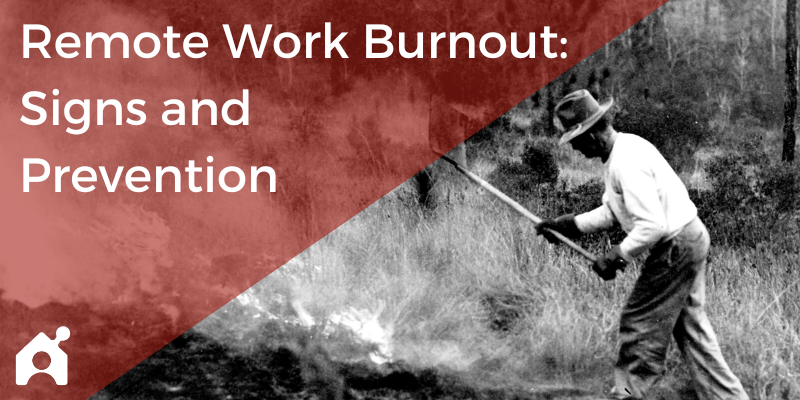Remote Work Burnout: Signs And Prevention Strategies

Remote work has become an increasingly popular arrangement. But nothing is perfect, and working remotely comes with numerous challenges companies and employees need to overcome to make the most of the flexibility and improved work/life balance that remote work offers.
Some of these challenges — like distractions — may be obvious, but burnout is a hidden trap that can go unnoticed until it severely affects employee health and productivity. That’s why it’s crucial to recognize the signs of burnout; doing so allows you to implement effective strategies to fight this issue and preserve your employees’ health and performance.
The Gravity Of Burnout
Burnout is a severe, stress-related condition that entails physical, emotional, and mental exhaustion. In remote work settings where supervision is minimal and self-motivation is key, burnout can become a significant issue affecting health and productivity — and increasing job dissatisfaction.
If you want to fight burnout effectively, you need to recognize its signs. Here are a few red flags that employers and employees should be mindful of:
- Feeling tired not just after a long day but consistently — even after rest.
- A noticeable drop in the quality and/or quantity of work, despite staying after hours.
- A lack of job enthusiasm and feeling overwhelmed by tasks that once were interesting and challenging.
- Withdrawing from team interactions and meetings.
- Increased irritability, frustration, or feelings of hopelessness.
Strategies To Prevent Burnout
- Insist On Regular Breaks: Remind your team that stepping away from their desks is a necessity that will let them take a breather, relax, and regain the focus needed for meaningful work.
- Promote Work-Life Balance: Show your employees how blurred the lines between work and private life can get, and help them set and stick to clear boundaries.
- Foster Open Communication: Create a supportive, non-judgmental environment where employees feel comfortable discussing negative aspects of work overload, tight deadlines, and increased stress and anxiety.
- Create Flexible Schedules: Allow employees to work during the hours they feel most productive in, acknowledging that everyone’s peak hours differ.
- Encourage Social Interactions: Organize virtual coffee breaks or social hours to mitigate the isolation that can come with remote work.
How Time Monitoring Software Can Be A Game-Changer
Time monitoring software is not just about oversight; it’s a tool for empowerment and support in the fight against burnout. Here’s how it can benefit employers and employees:
- Monitoring Work Patterns: Understanding the work patterns of employees allows employers to identify overwork and intervene before it leads to burnout.
- Ensuring Fair Work Distribution: Advanced data analytics help ensure tasks are evenly distributed, preventing overburdening any team member.
- Tracking Productivity Trends: Identifying drops in productivity can be a sign of burnout, enabling timely support and adjustments.
- Supporting Flexible Schedules: The data obtained from time monitoring software can help managers recognize and support each employee’s most productive times, promoting flexible work hours.
- Facilitating Transparent Communication: Data-backed insights make conversations about workload and efficiency easier, allowing you to foster an environment of understanding and support.
A Unified Front Against Burnout
Burnout in remote work settings may be difficult to eradicate, but you can battle it by creating a workplace that prioritizes productivity and safeguards employee well-being. To do that, take a look at the following strategies you can implement to slow or stop burnout entirely.
1. Prioritize Mental Health And Wellness
A focus on mental health and general well-being goes a long way in preventing burnout in remote work situations.
- Wellness Programs: Organize programs focusing on mental health, physical wellness, and stress management — and encourage your employees to participate in them. Workshops dedicated to meditation, yoga, and fitness can be incredibly beneficial.
- Mental Health Days: Include mental health days in your company benefits package. Physical health sometimes requires a day off for recovery; mental health should be treated with the same respect.
2. Enhance Skill Development And Career Growth
Satisfied and engaged employees are less likely to slip into burnout. To that end, you should invest in their training and education, helping them develop their skills and advance their careers.
- Continuous Learning: Ensure that employees have opportunities to learn new skills and grow in their careers. This can increase job satisfaction and reduce feelings of stagnation, which often contribute to burnout.
- Role Diversification: Allow employees to take on new, diverse projects outside their usual scope. Such opportunities can break monotony and keep work exciting.
3. Build A Community
Remote workers can often feel isolated and left out from the rest of their team, and lack of social interaction can lead to higher anxiety, depression, and — yes — burnout. Look into the following to keep your employees engaged with each other, their departments, and the rest of the company:
- Virtual Team Building: Creating a sense of belonging and community is vital in remote setups. Organize regular virtual activities that are not work-related to strengthen team bonds.
- Peer Support Groups: Facilitate the formation of support groups within the company where employees can share experiences and coping strategies.
